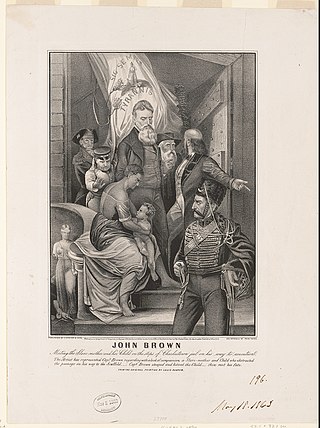
Melungeon was a slur historically applied to individuals and families of mixed-race ancestry with roots in colonial Virginia, Tennessee, and North Carolina primarily descended from free people of color and white settlers. In modern times, the term has been reclaimed by descendants of these families, especially in southern Appalachia. Despite this mixed heritage, many modern Melungeons pass as White, as did many of their ancestors.

The institution of slavery in the European colonies in North America, which eventually became part of the United States of America, developed due to a combination of factors. Primarily, the labor demands for establishing and maintaining European colonies resulted in the Atlantic slave trade. Slavery existed in every European colony in the Americas during the early modern period, and both Africans and indigenous peoples were targets of enslavement by Europeans during the era.

"Children of the plantation" is a euphemism used to refer to people with ancestry tracing back to the time of slavery in the United States in which the offspring was born to black African female slaves in the context of the trans-Atlantic slave trade and Non-Black men, usually the slave's owner, one of the owner's relatives, or the plantation overseer. These children were often considered to be the property of the slave owner and were often subjected to the same treatment as other slaves on the plantation. Many of these children were born into slavery and had no legal rights, as they were not recognized as the legitimate children of their fathers. The men who fathered these children often used their power and authority to force themselves upon the black females who were under their control.

In the context of the history of slavery in the Americas, free people of color were primarily people of mixed African, European, and Native American descent who were not enslaved. However, the term also applied to people born free who were primarily of black African descent with little mixture. They were a distinct group of free people of color in the French colonies, including Louisiana and in settlements on Caribbean islands, such as Saint-Domingue (Haiti), St. Lucia, Dominica, Guadeloupe, and Martinique. In these territories and major cities, particularly New Orleans, and those cities held by the Spanish, a substantial third class of primarily mixed-race, free people developed. These colonial societies classified mixed-race people in a variety of ways, generally related to visible features and to the proportion of African ancestry. Racial classifications were numerous in Latin America.

The Known World is a historical novel by American author Edward P. Jones, published in 2003. Set in antebellum Virginia, the novel explores the complex and morally ambiguous world of slavery, focusing on the unusual phenomenon of black enslavers. The book received widespread critical acclaim for its innovative storytelling, richly drawn characters, and profound examination of power, race, and the human condition in the context of American slavery.
Eston Hemings Jefferson was born into slavery at Monticello, the youngest son of Sally Hemings, a mixed-race enslaved woman. Most historians who have considered the question believe that his father was Thomas Jefferson, the third president of the United States. Evidence from a 1998 DNA test showed that a descendant of Eston matched the Jefferson male line, and historical evidence also supports the conclusion that Thomas Jefferson was probably Eston's father. Many historians believe that Jefferson and Sally Hemings had six children together, four of whom survived to adulthood. Other historians disagree.
Black Indians are Native American people – defined as Native American due to being affiliated with Native American communities and being culturally Native American – who also have significant African American heritage.
Plaçage was a recognized extralegal system in French and Spanish slave colonies of North America by which ethnic European men entered into civil unions with non-Europeans of African, Native American and mixed-race descent. The term comes from the French placer meaning "to place with". The women were not legally recognized as wives but were known as placées; their relationships were recognized among the free people of color as mariages de la main gauche or left-handed marriages. They became institutionalized with contracts or negotiations that settled property on the woman and her children and, in some cases, gave them freedom if they were enslaved. The system flourished throughout the French and Spanish colonial periods, reaching its zenith during the latter, between 1769 and 1803.
Anna Madgigine Jai Kingsley, born Anta Madjiguène Ndiaye, also known as Anna Kingsley, Anta Majigeen Njaay or Anna Madgigine Jai, was a West African from present-day Senegal, who was enslaved and sold in Cuba, probably via the slave pens on Gorée Island. In Cuba she was purchased, as wife, by plantation owner and slave trader Zephaniah Kingsley. After his death, she became a planter and slave owner in her own right, as a free Black woman in early 19th-century Florida.

Partus sequitur ventrem was a legal doctrine passed in colonial Virginia in 1662 and other English crown colonies in the Americas which defined the legal status of children born there; the doctrine mandated that children of enslaved mothers would inherit the legal status of their mothers. As such, children of enslaved women would be born into slavery. The legal doctrine of partus sequitur ventrem was derived from Roman civil law, specifically the portions concerning slavery and personal property (chattels), as well as the common law of personal property; analogous legislation existed in other civilizations including Medieval Egypt in Africa and Korea in Asia.
Black Dutch is a term with several different meanings in United States dialect and slang. It generally refers to racial, ethnic or cultural roots. Its meaning varies and such differences are contingent upon time and place. Several varied groups of multiracial people have sometimes been referred to as or identified as Black Dutch, most often as a reference to their ancestors.

Kingsley Plantation is the site of a former estate on Fort George Island, in Duval County, Florida, that was named for its developer and most famous owner, Zephaniah Kingsley, who spent 25 years there. It is located at the northern tip of Fort George Island at Fort George Inlet, and is part of the Timucuan Ecological and Historic Preserve managed by the U.S. National Park Service. Kingsley's house is the oldest plantation house still standing in Florida, and the solidly-built village of slave cabins is one of the best preserved in the United States. It is also "the oldest surviving antebellum Spanish Colonial plantation in the United States."

The Choctaw Freedmen are former enslaved Africans, Afro-Indigenous, and African Americans who were emancipated and granted citizenship in the Choctaw Nation after the Civil War, according to the tribe's new peace treaty of 1866 with the United States. The term also applies to their contemporary descendants.

Edward Ball is an American author who has written multiple works on topics such as history and biography. He is best known for works that explore the complex past of his family, whose members were major rice planters and slaveholders in South Carolina for nearly 300 years. One of his more well known works is based around an African-American family, descended from one member of this family and an enslaved woman, whose members became successful artists and musicians in the Jazz Age.
Multiracial Americans, also known as Mixed Americans, are Americans who have mixed ancestry of two or more races. The term may also include Americans of mixed-race ancestry who self-identify with just one group culturally and socially. In the 2020 United States census, 33.8 million individuals or 10.2% of the population, self-identified as multiracial. There is evidence that an accounting by genetic ancestry would produce a higher number.

Slave breeding was the practice in slave states of the United States of slave owners systematically forcing slaves to have children to increase their wealth. It included coerced sexual relations between enslaved men and women or girls, forced pregnancies of enslaved women and girls due to forced inter inbreeding with fellow slaves in hopes of producing relatively stronger future slaves. The objective was for slave owners to increase the number of people they enslaved without incurring the cost of purchase, and to fill labor shortages caused by the abolition of the Atlantic slave trade.

The treatment of slaves in the United States often included sexual abuse and rape, the denial of education, and punishments like whippings. Families were often split up by the sale of one or more members, usually never to see or hear of each other again.
John Punch was a Central African resident of the colony of Virginia who became its first enslaved person.

Slavery in Florida occurred among indigenous tribes and during Spanish rule. Florida's purchase by the United States from Spain in 1819 was primarily a measure to strengthen the system of slavery on Southern plantations, by denying potential runaways the formerly safe haven of Florida. Florida became a slave state, seceded, and passed laws to exile or enslave free blacks. Even after abolition, forced labor continued.












